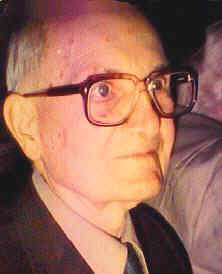From Small Beginnings A
Brief History of the Guelph, Note:29th May 1984
HOW I BECAME A RADIO AMATEUR After some years QRT, I joined
the KWARC Coffee Club in 1982. This made me interested once again in becoming an active
ham. So I sat for the DOC exam; passed it and have been issued with my new call sign
VE3NQR. That means NEVER QUITE READY Sometime after the advent of radio broadcasting, I purchased a kit of parts to build a crystal radio receiver. When it was completed, I put up an aerial wire, hooked a wire to the telephone ground rod, connected them to the radio, adjusted the crystal detector and IT WORKED. KDKA was coming in well. We used this radio for more than a year and received 28 different stations. At night, reception was from up to 1000 miles away. During this time I had been reading books on radio. Radio News Handbook had a circuit, a Reinartz one tube set which I decided to build. When this set was built and operative I could hear more stations. I was also able to tune to a higher band where I could hear the lake boats sending wireless signals by morse code and a few other stations which I later found out to be amateur radio stations. I needed a transmitter. I had a spark coil and a sending key. I wound the tuning coil, made a spark-gap and got a battery. When the transmitter was connected to the aerial, I phone my chum who lived a mile away and asked him to listen on his radio for my signal and to call me when he heard me. Soon my phone rang and very excitedly my chum said my signal was coming in very loud. With this success we decided that I would make another small transmitter for him. Soon we were able to talk back and forth with my call sign being NF and his LW. It was slow going at less than five words per minute. After several weeks of this, I got bolder and decided to call one of the other stations that I was hearing. Perhaps they could hear my signals too. VE3DS seemed to be the loudest signal so next time I heard him I gave him a call. Sure enough, he called me back and said he was in Kitchener. He asked me where I lived. I told him, out in the country about twelve miles north of Kitchener. He then told me they had been looking for NF and LW in Kitchener for weeks and could not find either of us. He also said our code signals were interfering with all the radio reception in town. He suggested that I tune my transmitter so that the signal was not so broad. I told him I would stay off the air from now on and that when I was next in Kitchener I would call to see him and get further advice. Not long afterwards, I was in Kitchener so called to see VE3DS. Much to my surprise and amazement he turned out to be the radio inspector for the district. However he was very nice and told me that to operate my radio station I would need to pass a test for morse code sending and receiving and for the operation and adjustment of radio equipment. Once this test was passed I would be granted a certificate of proficiency in radio and be issued an amateur radio licence. I practised code diligently and studied hard for a few weeks before going back to the inspector for the test. I passed without difficulty and on 19th April 1924 became the proud possessor of my certificate of proficiency in amateur radio with the call sign 3HM. I joined the American Radio Relay League and by visiting some of the hams in Kitchener and Galt soon found out what was going on in amateur radio circles. I did not get on the air regularly until 1926, when after much experimenting with low power transmitters, I finally found out what pleased me. It was a M.O.P.A., using a 201-B as oscillator and a 112-A as amplifier with 135 volts from B batteries. With this rig I covered a large part of Canada and the USA, generally getting good signal reports. I am proud to say my little transmitter was the source of;- "A CHIRP FROM THE STICKS." 73, NOTE: |
